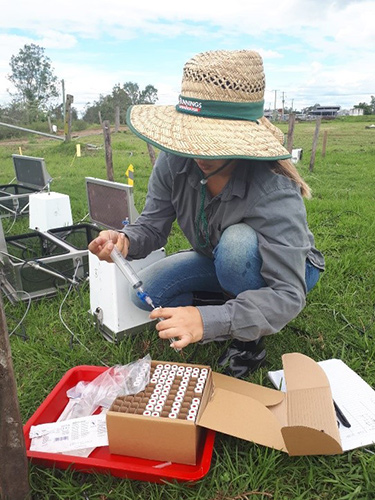Project updates
December, 2018
Karina arrived safely in Melbourne and is looking forward to beginning the project, learning new research skills and expanding her research network.
January, 2019
An incubation study was established to determine at what concentrations DMPP should be applied at in order to reduce rates of nitrification within emission hot-spots of dairy pastures. Briefly, soils were sampled from dairy pastures in Casino, NSW and Allansford, VIC. Soils were sampled from areas where cattle congregate, around water troughs and gateways, and from standard areas of pasture. The nitrification inhibitor DMPP was applied at increasing rates and incubated to determine the effects on nitrification rates.

March, 2019
Karina carried out a research visit to the Institute of Future Environments, Queensland University of Technology. Here she is working in collaboration with Dr, David Rowlings and Dr. Johannes Friedl to determine urine patch N2O emission factors from cattle urine, with or without DMPP, applied to soil around a gateway compared to that within standard pasture. Losses of N2O were monitored using an automated chamber system and losses of N2 were also quantified by using a stable isotope enrichment approach. Images below show establishment of the field trial and treatment application.


April, 2019
We welcomed CLIFF-GRADS student, Camila Almeida dos Santos to the Target-N2O research project. The CLIFF-GRADS fellowship is a joint initiative of the CGIAR Research Program on Climate Change (CCAFS) low emissions development and the Global Research Alliance on Agricultural Greenhouse Gases (GRA) and supports the capability of early-career scientists and graduate students form developing countries to conduct applied research on climate change mitigation in agriculture. Here Camila is assisting on the field trial established at Casino, NSW.

June, 2019
Work has been conducted in order to delineate the spatial extent of the zone of influence of cattle on soil properties as a function of distance away from a farm scale feature. Here soil cores are being taken at increasing distances away from a water trough on a dairy pasture in Allansford, Victoria. This will inform the next experiment where intact soil cores will be taken along a transect of degree of impact by livestock, and incubated to investigate the N2O emissions and N cycling microbial community dynamics.


August, 2019
A poster presentation was delivered at the 7th Greenhouse Gas and Animal Agriculture conference in Foz do Iguacu, Brazil. The conference was a great place to share early outputs of the Target-N2O project to an international audience of delegates. See below to download a copy of the poster.
September, 2019
The research completed on the project to date was presented at the linked More Profit from Nitrogen partner forum project meeting at the Gold Coast. An opportunity to update project collaborators and delegates of the Australian Fertilizer Industry Conference with the research.
October, 2019
An incubation study was established on intact soil cores from contrasting spatial locations within dairy farms, representing differing degrees of impact by livestock (i.e. increased congregation resulting in higher soil compaction, increased excretal deposition and reduced vegetative cover). The study assessed the magnitude of emissions of the greenhouse gas N2O and differences in soil properties within these contrasting locations, alongside investigating the soil molecular ecology in terms of nitrogen cycling gene abundance and activity through extraction of soil DNA and RNA. A research visit to the University of Western Australia is planned in early 2020 to complete the molecular ecology aspect of the project.


December, 2019
Work has begun on the modelling component of the project, here a biophysical pasture simulation model, DairyMod, is being utilised to explore the potential cost-benefits associated with the use of nitrification inhibitors within intensive dairy farms on improving nitrogen use efficiency at the farm scale.


